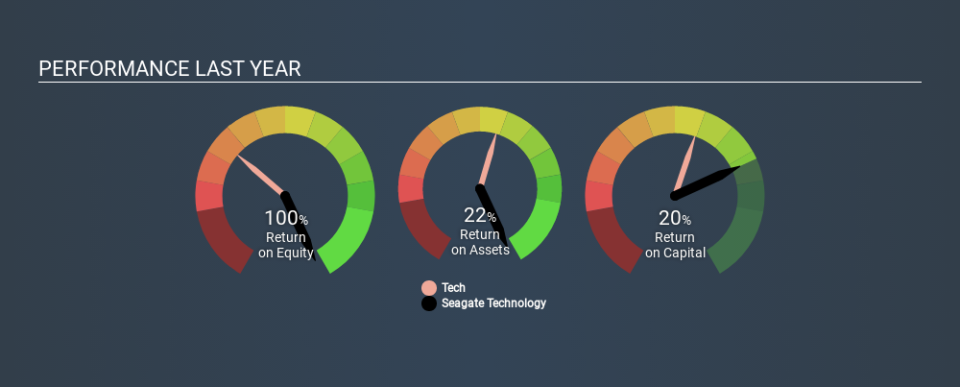Seagate Technology plc (NASDAQ:STX) Earns Among The Best Returns In Its Industry

Today we are going to look at Seagate Technology plc (NASDAQ:STX) to see whether it might be an attractive investment prospect. Specifically, we're going to calculate its Return On Capital Employed (ROCE), in the hopes of getting some insight into the business.
First of all, we'll work out how to calculate ROCE. Next, we'll compare it to others in its industry. Then we'll determine how its current liabilities are affecting its ROCE.
What is Return On Capital Employed (ROCE)?
ROCE measures the 'return' (pre-tax profit) a company generates from capital employed in its business. In general, businesses with a higher ROCE are usually better quality. Overall, it is a valuable metric that has its flaws. Author Edwin Whiting says to be careful when comparing the ROCE of different businesses, since 'No two businesses are exactly alike.
So, How Do We Calculate ROCE?
The formula for calculating the return on capital employed is:
Return on Capital Employed = Earnings Before Interest and Tax (EBIT) ÷ (Total Assets - Current Liabilities)
Or for Seagate Technology:
0.20 = US$1.2b ÷ (US$8.7b - US$2.5b) (Based on the trailing twelve months to October 2019.)
So, Seagate Technology has an ROCE of 20%.
See our latest analysis for Seagate Technology
Is Seagate Technology's ROCE Good?
One way to assess ROCE is to compare similar companies. Seagate Technology's ROCE appears to be substantially greater than the 8.9% average in the Tech industry. We consider this a positive sign, because it suggests it uses capital more efficiently than similar companies. Setting aside the comparison to its industry for a moment, Seagate Technology's ROCE in absolute terms currently looks quite high.
In our analysis, Seagate Technology's ROCE appears to be 20%, compared to 3 years ago, when its ROCE was 14%. This makes us think about whether the company has been reinvesting shrewdly. You can see in the image below how Seagate Technology's ROCE compares to its industry. Click to see more on past growth.
When considering this metric, keep in mind that it is backwards looking, and not necessarily predictive. Companies in cyclical industries can be difficult to understand using ROCE, as returns typically look high during boom times, and low during busts. ROCE is, after all, simply a snap shot of a single year. What happens in the future is pretty important for investors, so we have prepared a free report on analyst forecasts for Seagate Technology.
What Are Current Liabilities, And How Do They Affect Seagate Technology's ROCE?
Liabilities, such as supplier bills and bank overdrafts, are referred to as current liabilities if they need to be paid within 12 months. The ROCE equation subtracts current liabilities from capital employed, so a company with a lot of current liabilities appears to have less capital employed, and a higher ROCE than otherwise. To check the impact of this, we calculate if a company has high current liabilities relative to its total assets.
Seagate Technology has total liabilities of US$2.5b and total assets of US$8.7b. Therefore its current liabilities are equivalent to approximately 29% of its total assets. The fairly low level of current liabilities won't have much impact on the already great ROCE.
Our Take On Seagate Technology's ROCE
, Seagate Technology shapes up well under this analysis, but it is far from the only business delivering excellent numbers . You might also want to check this free collection of companies delivering excellent earnings growth.
I will like Seagate Technology better if I see some big insider buys. While we wait, check out this free list of growing companies with considerable, recent, insider buying.
If you spot an error that warrants correction, please contact the editor at editorial-team@simplywallst.com. This article by Simply Wall St is general in nature. It does not constitute a recommendation to buy or sell any stock, and does not take account of your objectives, or your financial situation. Simply Wall St has no position in the stocks mentioned.
We aim to bring you long-term focused research analysis driven by fundamental data. Note that our analysis may not factor in the latest price-sensitive company announcements or qualitative material. Thank you for reading.

 Yahoo News
Yahoo News 

